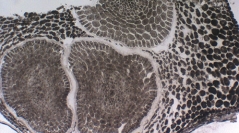

 Comptes Rendus Palevol
20 (43) - Pages 887-896
Comptes Rendus Palevol
20 (43) - Pages 887-896Barley (Hordeum vulgare L.) is one of the main domesticated cereals. For this reason, barley seeds have been found in numerous archaeological sites, and since the mid-19th century have been available in numerous natural museum collections. About a hundred years ago samples were collected in the African countries of Eritrea and Cyrenaica (now Libya), and have been preserved as ex-situ in the museum collection “L’Orientale” of the University of Naples. The varieties of contemporary barley selected for comparative analysis were grown in Tuscany and are used in the production of craft beer. To ascertain their vitality, the ancient and contemporary seeds were placed in Petri dishes to hydrate under a sterile hood at room temperature after a sterilization procedure. Morphological and ultrastructural observations performed on the aleurone cells of the ancient samples presented vital cells. The extraction and purification of DNA from seeds produced results while the genotype comparison of ancient and contemporary barley varieties enabled the construction of a dendrogram of similarity, useful in describing barley from museum genetic heritage collections and in providing a molecular imprint of extant varieties.
Aleurone cells, ancient DNA, dormancy seeds, factory beer, SSR nuclear genomic, ultrastructure